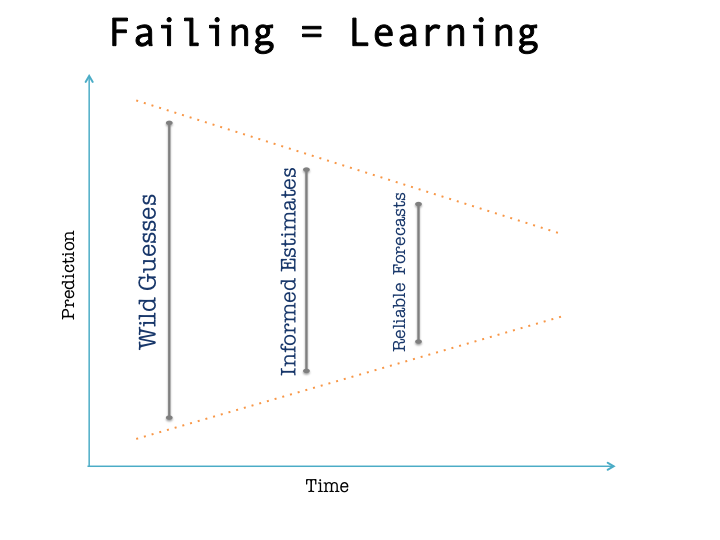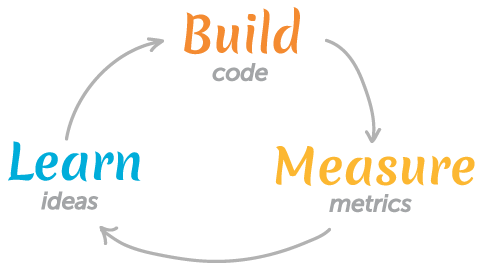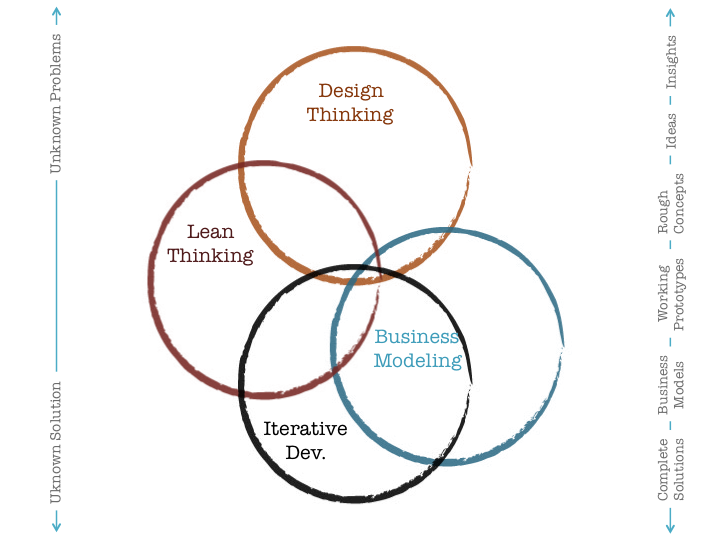Lets face it. No one denies the rough times businesses are facing nowadays! Shirking market shares, declining of profits, demanding customer needs, customer un-loyalty, scare of operating resources and last but not least the lack of good opportunities that can change the face of competition.



A question that may arise, where does lean thinking fits with concepts like business model development, Design Thinking and iterative development. The following diagram attempts to give you an answer!

All the above factors put a massive pressure on businesses to create viable pipeline of opportunities that can bring growth and differentiation, but what reality states, its not as easy as it sound! This is due to the current conditions of uncertainty that businesses work in nowadays, which make companies more exposable to being obsolete without any prior notification.
For example, a 500 fortune company life expectancy at the 50’s and 60’s where 60 years, where in the current days its no more than 18 years! Apply this to even lower scale businesses and the life expectancy numbers will shrink down dramatically.
So in this article, I will try to distill how lean thinking can be used as a mindset and as a methodology to change the face of competition, enable existing businesses to find what they are missing and survive the uncertain times we live in. My focus will be on established startups not new ones, the big guys not the small ones, the mature ones not the early comings.
So what is a startup, really?
Its worth while noting that this report is all about applying lean thinking in startups, but!
What is a startup? Is it two guys sitting in a garage doing code? can startup definition be attached to large corporations? Eric Ries defines a startup as:
“A human institution designed to create something new under conditions of extreme uncertainty" ~ Eric Ries
Looking at the above definition with an eye of thought, its clearly does not exclude any organization based on its size, maturity level, industry it operates at or any other factors we may programmed our self to take for granted as part of a startup definition.
This is a fundamental building block this article is building on, where the working knowledge out of it can be utilized in different business maturity levels, be it an early startup or a mature organization but with more focus on the former.
Now, going to uncertainty!
Demystifying uncertainty in the business context.
When looking at uncertainty from high level business point of view, it can be defined as:
“Situation where the current state of knowledge such as the order or nature of things is unknown, the consequences, or magnitude of circumstances, conditions, or events is unpredictable, and credible probabilities to possible outcomes cannot be assigned” ~ Business Dictionary
So taking from the definition we can try to visualise uncertainty into levels, where its starts very low (aka simple) and to be very high (aka chaotic). The following diagram explains uncertainty by showing what to do, how to behave and listing some examples for that.
Figure1: Uncertainty levels
We can see clearly that the area of startup / entrepreneurship is an area of exploration and learning, this is where its different from the current “Ship It!” traditional thinking of new opportunity development.
The "Ship It!" conventional development (aka product development).
“There is nothing so useless as doing efficiently that which should not be done at all.” ~ Peter Drucker
What happens in today mature businesses world is what called the the “Ship It!” syndrome. In this, enterprises trying to make sure that there are efficiently delivering what they think that customers wants using a good planning, solid strategy and efficient execution. That all is great, but this all fly when the problem is known and the solution is also known!
Mature businesses are building on practices which are pile of years and years of doing the same things efficiently using product development methodologies, but in finding new opportunities (that contains uncertainty) this all does not make any sense, since the fundamental problem is unknown and logically also the solution.
What I mean by the fundamental problem is, what are the “real” needs that we are building our compelling value for? Are we are providing customers something that will really match their needs? To know this, we need to start from the customers not from our intuition.
This is where the concepts like product development falls apart and we need a better way to approach our new opportunity development efforts. No offense to product development, but it works well for incremental type of opportunity development where you have the problem is already know and the how we approach solution also.
Figure 2: Areas of product development
Lean development to the rescue (aka customer development).
Now is the time to give an answer to our stated problem, how businesses can find new opportunities in the current uncertain situations utilizing the least resources possible?
By applying lean development to their new opportunity development. Lean development is all about about applying a scientific methodology to validate a certain hypothesis or a theory. Its all about having the mindset to accept the changes in the enterprise that shift the thinking from the “Ship it!” or the organization driven opportunity development mindset to a more customer driven opportunity development mindset.
It requires changes both at the process / methodology level and the enterprise level to accommodate such type of thinking. For example, a culture of embracing failure and taking it as a learning opportunity must be established for such type of shift to work within enterprise.
Lean is a mindset change that takes development effort to answer the question: should we build something NOT can we build it! As it tries to find a validated customer learning in the minimal efforts possible to optimize the resources utilization for further learning and explorations.
Lean thinking, a primer.
Lean thinking builds on couple of concepts that are once understood they are very easy to apply if the right will is in place.
The first and the most important concepts is the term pivot, which is building block for lean thinking as a whole. Pivot defined as:
“Structured course correction designed to test a new fundamental hypothesis about the product, strategy, and engine of growth.” ~ Wikipedia
For a pivot to happen, we have to have a certain hypotheses where we start from and then try to go in one direction and see if its that direction takes to achieve our goals. This happens by quickly and fastly by validating our hypothesis against our potential customers and accessing both qualitatively and quantitatively if we are on the right track or not. If we feel we are not on the right track, we stay grounded to what we have learned but we change our direction trying to find a better course of action.
The whole concept of pivot is about learning and quickly, since the main unit of success in lean thinking is how many pivots we can achieve before we run out of our assigned resources (ex: money).
Figure 3: Failing as learning process
The second important concept in lean thinking is minimal valuable product (MVP), which is defined as :
"version of a new product which allows a team to collect the maximum amount of validated learning about customers with the least effort." ~ Wikipedia
So in contrary to what we have learned in conventional business / development schools, an MVP can be anything like an explainer video, a landing page, a 3D printed sample or even can be a crowdfunding campaign in Kickstart or so. The goal of a MVP is to test the fundamental hypothesis and to help entrepreneurs begin the learning process as quickly as possible.
The third more important concept in lean thinking is the concept of actionable metrics or innovation accounting as Eric Ries likes to call it. Where its a set of metrics that are defined from a customer point of view and track the customer behavior while interacting with our MVP. The sole purpose of these metrics is to provide a way to lead to more informed business decisions and subsequent actions.
The fourth concept is the concept of preserving, which is sticking to a certain course of action after seeing that the actionable metrics are complying to the business defined thresholds.
On important aspect of lean thinking also is to have regular decision meetings to decide on when to pivot and when to preserve a course of action.
This helps to validate the current learnings and build on it for a better situation of to be developed business opportunity. Another important thing is to iteratively check the and validate the MVP with the customer in continuous development matter as highlighted in the image below.
Figure 4: Continuous development / learning lean process
How to apply learning thinking / development in your company?
Now comes the real interesting part, how we can apply lean thinking / development in an established sizeable company?
The first and foremost important step is to prepare your mindset to accept the lean thinking as whole package. Yes! you should accept that failure is keystone in your learning process, you should accept that kitching your development upfront won't work, you should accept that customers only know really what they want, you should accept that finding innovations is not a linear process and finally you should accept that what works best for you today may not work for tomorrow, so be ready!
So here is an action plan for incorporating lean thinking into your established company:
- Find the passion for applying lean thinking in your company: applying lean thinking in conventional business is a change, and with any change it has to have reasons that engage people emotionally before rationally. Let it be declining revenues, declining market share or decreased customer satisfaction index. All you need is to find the right trigger in your case to liue the road for introducing lean thinking in your company.
- Define a vision of what you want to achieve with lean thinking: Lean thinking is not a vision, its a way to reach what you want to achieve. Set clear goals for your lean thinking, what do you want achieve out of it and what is the future post card you want to pursue.
- Avoid entreprise politics and define a clear sandbox for applying lean thinking experiments: To minimize the internal resistance for your lean thinking efforts, find a sweet spot where you can play freely and have the chance to explore. This will need a window to access customers but with expectations set upfront, which is the next point.
- Set the customer expectations right: For your efforts to not damage your current business image, define a BETA brand for exploring and executing your lean thinking efforts. This will help in setting the customer expectation about what you're providing are not a full fledged solutions or market ready ones.
- Discover the real customer problems: Always start with the customer, understand what their real needs are! Its fine that you start with a hypothesis but validate it from there. Whatever you think is the problem may not be the right one. remember, when you go lean you need to know "what is the right to do" first before "doing things right!" As Steve Blank said “Get out of the building!”.
- Create minimal value products / services and ship early: There are many ways to have validated customer feedback without ever building the full product / service at all! Select the best method that suits your customer base, be it a teaser video, a landing page or so.
- Define the right customer behaviour measurement metrics: Before putting your MVP in your customers hand, define what behaviours you expect from them and how you will measure it. In this phase you will need also to define certain thresholds that you need to pass to continue to the next phase in your lean iterative development.
- Validate your proposed solutions: Expose your minimal value product to your customers often to learn and get insights about where to go next from here.
- Pivot or persevere: Do regular meetings with your team to validate if your metrics against current and real customer behaviours. It may be the time to pivot or persevere you current course of action.
- Create a transition monumentum and plan: If everything goes well with your lean efforts, align your business unit how will be scaling the solution into a commercial one. Show them customer feedback and happiness about your solution, and dont forget to build a mini business case about what need to be done (A business model canvas may be a good option here).
- Back to square zero, start again! Time to go back to a new exploration journey! Well done :)
Do big enterprises do lean?
One company Intuit managed to implement lean thinking in its development process. The result, reduced development cycle time and an improvement in the overall quality of their products due to higher levels of customer involvement. After spending tremendous efforts into the development of products that never really took off, the company pivoted its own R&D processes to be more lean.
Bonus, where lean fits in the bigger picture?
A question that may arise, where does lean thinking fits with concepts like business model development, Design Thinking and iterative development. The following diagram attempts to give you an answer!
Figure 5: Lean thinking in a full picture
As you see design thinking process can be used as vehicle to generate idea insights and ideas that can be later validated using the lean thinking approach and methods.
Conclusion
Its clear that lean thinking and practices are not just for those in a garage! We all have to know and practice such methodology in these turbulent uncertain times.
It all start with a mindset and then a action. Make sure you fit a slot in your development efforts for practicing lean thinking even at smaller projects scale. No one knows, it may turn into a habit for you.
No comments:
Post a Comment